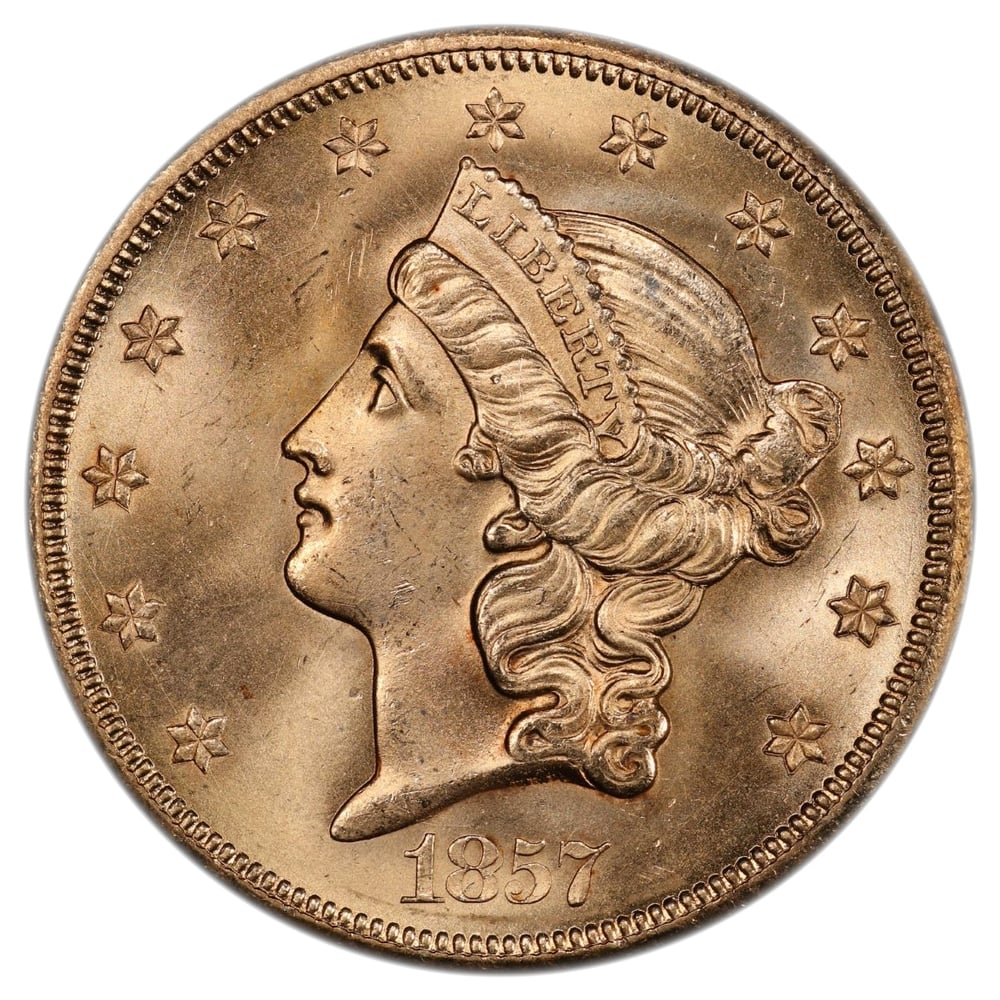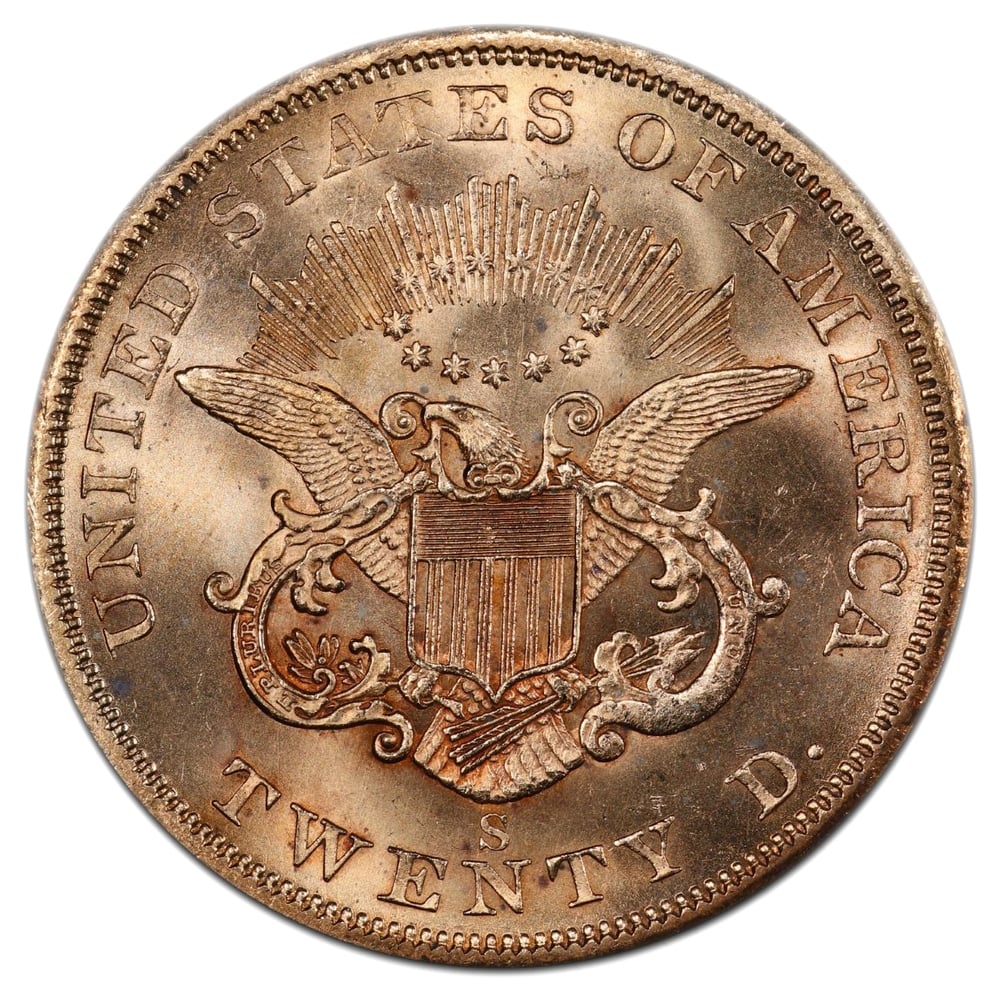About Numiis / Numis DB
The numismatic database project is designed to provide all information any coin collector or numismatist would need regarding a coin, medal or note of interest.
The liberty head double eagle value ranges from $1 to $100,000 depending on the quality of the coin, which year it was minted in, which mint it was manufactured at, and its strike type.


The discovery of gold in California, and the resulting California Gold Rush, led to a sudden influx of gold bullion needing to be minted. At the time, the largest-denomination coin in circulation was the gold Eagle, worth $10, followed by the Half Eagle ($5) and the Quarter Eagle ($2.50). In the early days of the Gold Rush, the bullion was minted into Quarter Eagles. It became swiftly apparent that the massive influx of gold would require minting a larger coin in a larger denomination. Calls had existed as early as 1836 to mint both a $1 and $20 gold coin, and indeed legislation was already underway to create the $1 coin. The need for a larger coin led to the addition of a $20 piece to the bill, which was approved on March 3rd, 1949.
The coin was designed by Chief Engraver James Barton Longacre, who had designed multiple other notable U.S. coins. The first developmental patterns were struck without a date in early January, 1850, and the Double Eagle finally entered circulation on January 26th, 1850. Production continued until 1866 when, in an effort to aid efforts at healing the nation after the American Civil War, the idea arose to create a religious motto for the nation and add it to all U.S. coinage - resulting in the addition of "In God We Trust" to newly minted coins. Notably, 1866-S Double Eagles can be found in both the original design, and with the motto as both were minted that year. Additionally, the coin underwent an additional redesign in 1877 when Chief Engraver William Barber tilted Goddess Liberty's head forward and changed the way the denomination was written. The coin remained in production until replaced by the Saint-Gaudens Double Eagle in 1907, and many remained in circulation until recalled by President Franklin D. Roosevelt in 1933 to be melted down in an attempt to boost the economy during the height of the Great Depression.
While exact totals are difficult to come by, it is likely that close to one hundred million Liberty Head Double Eagles were minted in total. Between the Philadelphia, Carson City, and San Francisco mints, 16,160,758 type 2 Double Eagles were produced during their eleven year run. Type 3 Double Eagles were the most heavily minted, with 64,137,477 pieces minted. Type 3 Double Eagles were primarily minted in Philadelphia and San Francisco, with the Carson City, New Orleans, and Denver mints augmenting production periodically as needed.
ID: 77
 1850 $20 Ms
Mint Strike
1850 $20 Ms
Mint Strike
 1850 O $20 Ms
Mint Strike
1850 O $20 Ms
Mint Strike
 1851 $20 Ms
Mint Strike
1851 $20 Ms
Mint Strike
 1851 O $20 Ms
Mint Strike
1851 O $20 Ms
Mint Strike
 1852 $20 Ms
Mint Strike
1852 $20 Ms
Mint Strike
 1852 O $20 Ms
Mint Strike
1852 O $20 Ms
Mint Strike
 1852 O $20 Sp
Special
1852 O $20 Sp
Special
 1853 $20 Ms
Mint Strike
1853 $20 Ms
Mint Strike
 1853 O $20 Ms
Mint Strike
1853 O $20 Ms
Mint Strike
 1853 O $20 Sp
Special
1853 O $20 Sp
Special
 1854 $20 Ms
Mint Strike
1854 $20 Ms
Mint Strike
 1854 Small Date $20 Ms
Mint Strike
1854 Small Date $20 Ms
Mint Strike
 1854 Large Date $20 Ms
Mint Strike
1854 Large Date $20 Ms
Mint Strike
 1854 S $20 Ms
Mint Strike
1854 S $20 Ms
Mint Strike
 1854 O $20 Ms
Mint Strike
1854 O $20 Ms
Mint Strike
 1855 $20 Ms
Mint Strike
1855 $20 Ms
Mint Strike
 1855 S $20 Ms
Mint Strike
1855 S $20 Ms
Mint Strike
 1855 O $20 Ms
Mint Strike
1855 O $20 Ms
Mint Strike
 1856 $20 Ms
Mint Strike
1856 $20 Ms
Mint Strike
 1856 S $20 Ms
Mint Strike
1856 S $20 Ms
Mint Strike
 1856 O $20 Ms
Mint Strike
1856 O $20 Ms
Mint Strike
 1857 $20 Ms
Mint Strike
1857 $20 Ms
Mint Strike
 1857 S $20 Ms
Mint Strike
1857 S $20 Ms
Mint Strike
 1857 O $20 Ms
Mint Strike
1857 O $20 Ms
Mint Strike
 1858 $20 Ms
Mint Strike
1858 $20 Ms
Mint Strike
 1858 S $20 Ms
Mint Strike
1858 S $20 Ms
Mint Strike
 1858 O $20 Ms
Mint Strike
1858 O $20 Ms
Mint Strike
 1859 $20 Ms
Mint Strike
1859 $20 Ms
Mint Strike
 1859 $20 Pf
Proof
1859 $20 Pf
Proof
 1859 S $20 Ms
Mint Strike
1859 S $20 Ms
Mint Strike
 1859 O $20 Ms
Mint Strike
1859 O $20 Ms
Mint Strike
 1860 $20 Ms
Mint Strike
1860 $20 Ms
Mint Strike
 1860 $20 Pf
Proof
1860 $20 Pf
Proof
 1860 S $20 Ms
Mint Strike
1860 S $20 Ms
Mint Strike
 1860 O $20 Ms
Mint Strike
1860 O $20 Ms
Mint Strike
 1861 $20 Ms
Mint Strike
1861 $20 Ms
Mint Strike
 1861 Paquet $20 Ms
Mint Strike
1861 Paquet $20 Ms
Mint Strike
 1861 $20 Pf
Proof
1861 $20 Pf
Proof
 1861 S $20 Ms
Mint Strike
1861 S $20 Ms
Mint Strike
 1861 S Paquet $20 Ms
Mint Strike
1861 S Paquet $20 Ms
Mint Strike
 1861 O $20 Ms
Mint Strike
1861 O $20 Ms
Mint Strike
 1862 $20 Ms
Mint Strike
1862 $20 Ms
Mint Strike
 1862 $20 Pf
Proof
1862 $20 Pf
Proof
 1862 S $20 Ms
Mint Strike
1862 S $20 Ms
Mint Strike
 1863 $20 Ms
Mint Strike
1863 $20 Ms
Mint Strike
 1863 $20 Pf
Proof
1863 $20 Pf
Proof
 1863 S $20 Ms
Mint Strike
1863 S $20 Ms
Mint Strike
 1864 $20 Ms
Mint Strike
1864 $20 Ms
Mint Strike
 1864 $20 Pf
Proof
1864 $20 Pf
Proof
 1864 S $20 Ms
Mint Strike
1864 S $20 Ms
Mint Strike
 1865 $20 Ms
Mint Strike
1865 $20 Ms
Mint Strike
 1865 $20 Pf
Proof
1865 $20 Pf
Proof
 1865 S $20 Ms
Mint Strike
1865 S $20 Ms
Mint Strike
 1866 Motto $20 Ms
Mint Strike
1866 Motto $20 Ms
Mint Strike
 1866 Motto $20 Pf
Proof
1866 Motto $20 Pf
Proof
 1866 S No Motto $20 Ms
Mint Strike
1866 S No Motto $20 Ms
Mint Strike
 1866 S Motto $20 Ms
Mint Strike
1866 S Motto $20 Ms
Mint Strike
 1867 $20 Ms
Mint Strike
1867 $20 Ms
Mint Strike
 1867 $20 Pf
Proof
1867 $20 Pf
Proof
 1867 S $20 Ms
Mint Strike
1867 S $20 Ms
Mint Strike
 1868 $20 Ms
Mint Strike
1868 $20 Ms
Mint Strike
 1868 $20 Pf
Proof
1868 $20 Pf
Proof
 1868 S $20 Ms
Mint Strike
1868 S $20 Ms
Mint Strike
 1869 $20 Ms
Mint Strike
1869 $20 Ms
Mint Strike
 1869 $20 Pf
Proof
1869 $20 Pf
Proof
 1869 S $20 Ms
Mint Strike
1869 S $20 Ms
Mint Strike
 1870 $20 Ms
Mint Strike
1870 $20 Ms
Mint Strike
 1870 $20 Pf
Proof
1870 $20 Pf
Proof
 1870 S $20 Ms
Mint Strike
1870 S $20 Ms
Mint Strike
 1870 Cc $20 Ms
Mint Strike
1870 Cc $20 Ms
Mint Strike
 1871 $20 Ms
Mint Strike
1871 $20 Ms
Mint Strike
 1871 $20 Pf
Proof
1871 $20 Pf
Proof
 1871 S $20 Ms
Mint Strike
1871 S $20 Ms
Mint Strike
 1871 Cc $20 Ms
Mint Strike
1871 Cc $20 Ms
Mint Strike
 1872 $20 Ms
Mint Strike
1872 $20 Ms
Mint Strike
 1872 $20 Pf
Proof
1872 $20 Pf
Proof
 1872 S $20 Ms
Mint Strike
1872 S $20 Ms
Mint Strike
 1872 Cc $20 Ms
Mint Strike
1872 Cc $20 Ms
Mint Strike
 1873 Closed 3 $20 Ms
Mint Strike
1873 Closed 3 $20 Ms
Mint Strike
 1873 Open 3 $20 Ms
Mint Strike
1873 Open 3 $20 Ms
Mint Strike
 1873 $20 Pf
Proof
1873 $20 Pf
Proof
 1873 S $20 Ms
Mint Strike
1873 S $20 Ms
Mint Strike
 1873 S Closed 3 $20 Ms
Mint Strike
1873 S Closed 3 $20 Ms
Mint Strike
 1873 S Open 3 $20 Ms
Mint Strike
1873 S Open 3 $20 Ms
Mint Strike
 1873 Cc $20 Ms
Mint Strike
1873 Cc $20 Ms
Mint Strike
 1874 $20 Ms
Mint Strike
1874 $20 Ms
Mint Strike
 1874 $20 Pf
Proof
1874 $20 Pf
Proof
 1874 S $20 Ms
Mint Strike
1874 S $20 Ms
Mint Strike
 1874 Cc $20 Ms
Mint Strike
1874 Cc $20 Ms
Mint Strike
 1875 $20 Ms
Mint Strike
1875 $20 Ms
Mint Strike
 1875 $20 Pf
Proof
1875 $20 Pf
Proof
 1875 S $20 Ms
Mint Strike
1875 S $20 Ms
Mint Strike
 1875 Cc $20 Ms
Mint Strike
1875 Cc $20 Ms
Mint Strike
 1876 $20 Ms
Mint Strike
1876 $20 Ms
Mint Strike
 1876 $20 Pf
Proof
1876 $20 Pf
Proof
 1876 S $20 Ms
Mint Strike
1876 S $20 Ms
Mint Strike
 1876 Cc $20 Ms
Mint Strike
1876 Cc $20 Ms
Mint Strike
 1877 $20 Ms
Mint Strike
1877 $20 Ms
Mint Strike
 1877 $20 Pf
Proof
1877 $20 Pf
Proof
 1877 S $20 Ms
Mint Strike
1877 S $20 Ms
Mint Strike
 1877 Cc $20 Ms
Mint Strike
1877 Cc $20 Ms
Mint Strike
 1878 $20 Ms
Mint Strike
1878 $20 Ms
Mint Strike
 1878 $20 Pf
Proof
1878 $20 Pf
Proof
 1878 S $20 Ms
Mint Strike
1878 S $20 Ms
Mint Strike
 1878 Cc $20 Ms
Mint Strike
1878 Cc $20 Ms
Mint Strike
 1879 $20 Ms
Mint Strike
1879 $20 Ms
Mint Strike
 1879 $20 Pf
Proof
1879 $20 Pf
Proof
 1879 S $20 Ms
Mint Strike
1879 S $20 Ms
Mint Strike
 1879 O $20 Ms
Mint Strike
1879 O $20 Ms
Mint Strike
 1879 Cc $20 Ms
Mint Strike
1879 Cc $20 Ms
Mint Strike
 1880 $20 Ms
Mint Strike
1880 $20 Ms
Mint Strike
 1880 $20 Pf
Proof
1880 $20 Pf
Proof
 1880 S $20 Ms
Mint Strike
1880 S $20 Ms
Mint Strike
 1881 $20 Ms
Mint Strike
1881 $20 Ms
Mint Strike
 1881 $20 Pf
Proof
1881 $20 Pf
Proof
 1881 S $20 Ms
Mint Strike
1881 S $20 Ms
Mint Strike
 1882 $20 Ms
Mint Strike
1882 $20 Ms
Mint Strike
 1882 $20 Pf
Proof
1882 $20 Pf
Proof
 1882 S $20 Ms
Mint Strike
1882 S $20 Ms
Mint Strike
 1882 Cc $20 Ms
Mint Strike
1882 Cc $20 Ms
Mint Strike
 1883 $20 Pf
Proof
1883 $20 Pf
Proof
 1883 S $20 Ms
Mint Strike
1883 S $20 Ms
Mint Strike
 1883 Cc $20 Ms
Mint Strike
1883 Cc $20 Ms
Mint Strike
 1884 $20 Pf
Proof
1884 $20 Pf
Proof
 1884 S $20 Ms
Mint Strike
1884 S $20 Ms
Mint Strike
 1884 Cc $20 Ms
Mint Strike
1884 Cc $20 Ms
Mint Strike
 1885 $20 Ms
Mint Strike
1885 $20 Ms
Mint Strike
 1885 $20 Pf
Proof
1885 $20 Pf
Proof
 1885 S $20 Ms
Mint Strike
1885 S $20 Ms
Mint Strike
 1885 Cc $20 Ms
Mint Strike
1885 Cc $20 Ms
Mint Strike
 1886 $20 Ms
Mint Strike
1886 $20 Ms
Mint Strike
 1886 $20 Pf
Proof
1886 $20 Pf
Proof
 1887 $20 Pf
Proof
1887 $20 Pf
Proof
 1887 S $20 Ms
Mint Strike
1887 S $20 Ms
Mint Strike
 1888 $20 Ms
Mint Strike
1888 $20 Ms
Mint Strike
 1888 $20 Pf
Proof
1888 $20 Pf
Proof
 1888 S $20 Ms
Mint Strike
1888 S $20 Ms
Mint Strike
 1889 $20 Pf
Proof
1889 $20 Pf
Proof
 1889 S $20 Ms
Mint Strike
1889 S $20 Ms
Mint Strike
 1889 $20 Ms
Mint Strike
1889 $20 Ms
Mint Strike
 1889 Cc $20 Ms
Mint Strike
1889 Cc $20 Ms
Mint Strike
 1890 $20 Ms
Mint Strike
1890 $20 Ms
Mint Strike
 1890 $20 Pf
Proof
1890 $20 Pf
Proof
 1890 S $20 Ms
Mint Strike
1890 S $20 Ms
Mint Strike
 1890 Cc $20 Ms
Mint Strike
1890 Cc $20 Ms
Mint Strike
 1891 $20 Ms
Mint Strike
1891 $20 Ms
Mint Strike
 1891 $20 Pf
Proof
1891 $20 Pf
Proof
 1891 S $20 Ms
Mint Strike
1891 S $20 Ms
Mint Strike
 1891 Cc $20 Ms
Mint Strike
1891 Cc $20 Ms
Mint Strike
 1892 $20 Ms
Mint Strike
1892 $20 Ms
Mint Strike
 1892 $20 Pf
Proof
1892 $20 Pf
Proof
 1892 S $20 Ms
Mint Strike
1892 S $20 Ms
Mint Strike
 1892 Cc $20 Ms
Mint Strike
1892 Cc $20 Ms
Mint Strike
 1893 $20 Ms
Mint Strike
1893 $20 Ms
Mint Strike
 1893 $20 Pf
Proof
1893 $20 Pf
Proof
 1893 S $20 Ms
Mint Strike
1893 S $20 Ms
Mint Strike
 1893 Cc $20 Ms
Mint Strike
1893 Cc $20 Ms
Mint Strike
 1894 $20 Ms
Mint Strike
1894 $20 Ms
Mint Strike
 1894 $20 Pf
Proof
1894 $20 Pf
Proof
 1894 S $20 Ms
Mint Strike
1894 S $20 Ms
Mint Strike
 1895 $20 Ms
Mint Strike
1895 $20 Ms
Mint Strike
 1895 $20 Pf
Proof
1895 $20 Pf
Proof
 1895 S $20 Ms
Mint Strike
1895 S $20 Ms
Mint Strike
 1896 $20 Ms
Mint Strike
1896 $20 Ms
Mint Strike
 1896 $20 Pf
Proof
1896 $20 Pf
Proof
 1896 S $20 Ms
Mint Strike
1896 S $20 Ms
Mint Strike
 1897 $20 Ms
Mint Strike
1897 $20 Ms
Mint Strike
 1897 $20 Pf
Proof
1897 $20 Pf
Proof
 1897 S $20 Ms
Mint Strike
1897 S $20 Ms
Mint Strike
 1898 $20 Ms
Mint Strike
1898 $20 Ms
Mint Strike
 1898 $20 Pf
Proof
1898 $20 Pf
Proof
 1898 S $20 Ms
Mint Strike
1898 S $20 Ms
Mint Strike
 1899 $20 Ms
Mint Strike
1899 $20 Ms
Mint Strike
 1899 $20 Pf
Proof
1899 $20 Pf
Proof
 1899 S $20 Ms
Mint Strike
1899 S $20 Ms
Mint Strike
 1900 $20 Sp
Special
1900 $20 Sp
Special
 1900 $20 Ms
Mint Strike
1900 $20 Ms
Mint Strike
 1900 $20 Pf
Proof
1900 $20 Pf
Proof
 1900 S $20 Ms
Mint Strike
1900 S $20 Ms
Mint Strike
 1901 $20 Ms
Mint Strike
1901 $20 Ms
Mint Strike
 1901 $20 Pf
Proof
1901 $20 Pf
Proof
 1901 S $20 Ms
Mint Strike
1901 S $20 Ms
Mint Strike
 1902 $20 Ms
Mint Strike
1902 $20 Ms
Mint Strike
 1902 $20 Pf
Proof
1902 $20 Pf
Proof
 1902 S $20 Ms
Mint Strike
1902 S $20 Ms
Mint Strike
 1903 $20 Ms
Mint Strike
1903 $20 Ms
Mint Strike
 1903 $20 Pf
Proof
1903 $20 Pf
Proof
 1903 S $20 Ms
Mint Strike
1903 S $20 Ms
Mint Strike
 1904 $20 Ms
Mint Strike
1904 $20 Ms
Mint Strike
 1904 $20 Pf
Proof
1904 $20 Pf
Proof
 1904 S $20 Ms
Mint Strike
1904 S $20 Ms
Mint Strike
 1905 $20 Ms
Mint Strike
1905 $20 Ms
Mint Strike
 1905 $20 Pf
Proof
1905 $20 Pf
Proof
 1905 S $20 Ms
Mint Strike
1905 S $20 Ms
Mint Strike
 1906 $20 Ms
Mint Strike
1906 $20 Ms
Mint Strike
 1906 $20 Pf
Proof
1906 $20 Pf
Proof
 1906 S $20 Ms
Mint Strike
1906 S $20 Ms
Mint Strike
 1906 D $20 Ms
Mint Strike
1906 D $20 Ms
Mint Strike
 1907 Liberty $20 Ms
Mint Strike
1907 Liberty $20 Ms
Mint Strike
 1907 Liberty $20 Pf
Proof
1907 Liberty $20 Pf
Proof
 1907 S $20 Ms
Mint Strike
1907 S $20 Ms
Mint Strike
 1907 D $20 Ms
Mint Strike
1907 D $20 Ms
Mint Strike
 1907 D $20 Pf
Proof
1907 D $20 Pf
Proof
 1907 D $20 Sp
Special
1907 D $20 Sp
Special
Sign up for exclusive access to the latest price trends, intelligence, auctions and more!
Gold $1,865.28 |
Silver $25.56 |
Platinum $998.24 |
Palladium $2,326.45
(Updated 2020-12-22)